Christmas Pudding!
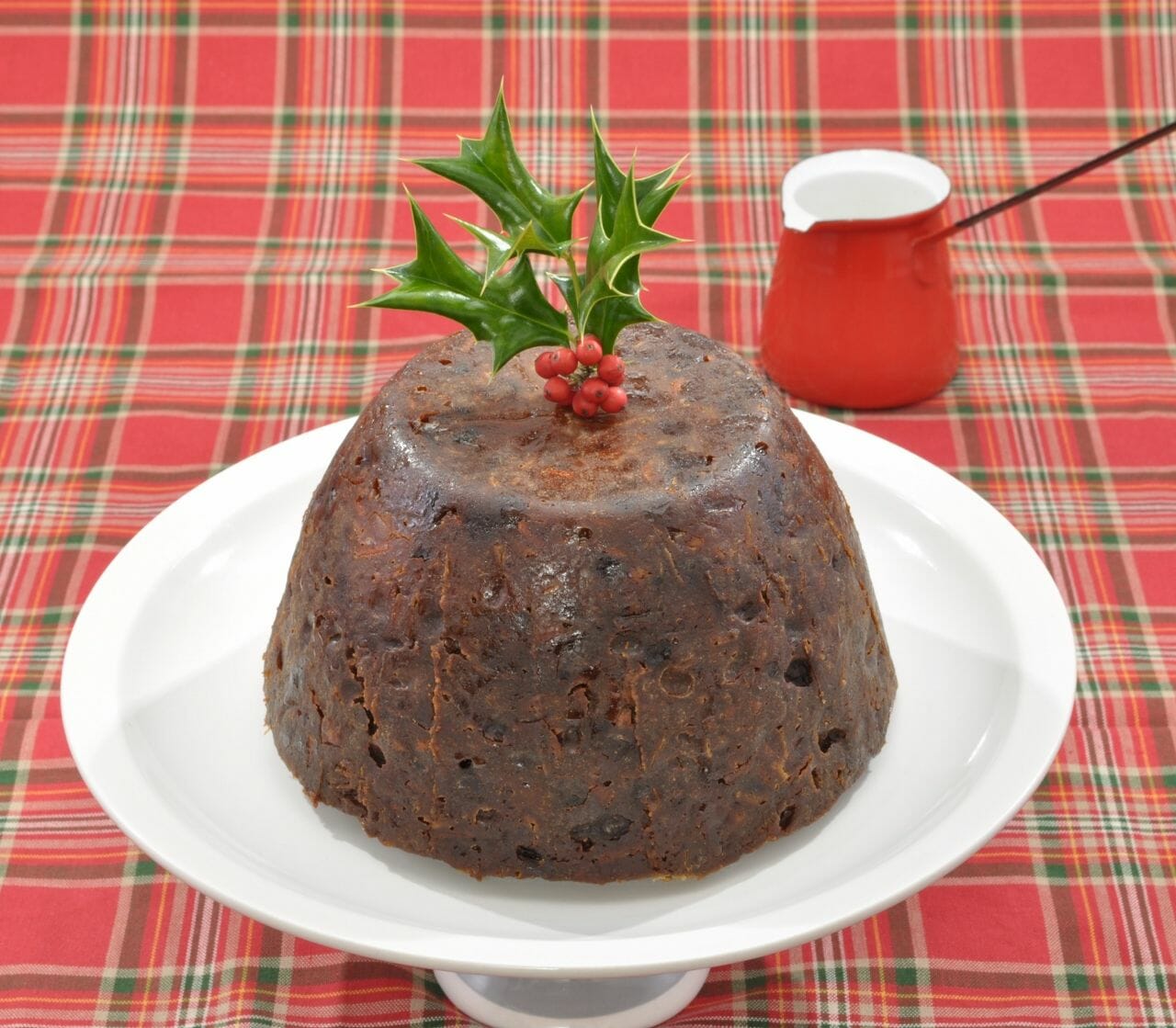
Traditional Christmas Pudding
It had been my intention to continue discussing holiday treats all December long. After reading my blog last week about the Bûche de Noël, Scott suggested sharing the history of the English Steamed Plum Pudding. While I loved the idea (I’m always open to suggestions), this American girl has never even HAD Plum Pudding! Luckily for me, Scott knew much about the history and traditions behind this beloved dessert from his own personal research.
That leads me to introduce my very special guest blogger today- Scott Ewing! Not only will Scott share the history of Plum Pudding, he will be sharing his personal recipe as well!
The History and Lore of the Steamed Christmas Pudding
Fruitcake. That single word results in either a positive, “I love fruitcake!” or a scrunched up face and a disgruntled, “Fruitcake. Yuck!” It seems that people either love it or hate it. But before there was fruitcake, there was Steamed Puddings, the forerunner of today’s fruitcake, made especially for the Christmas Day meal; these puddings were steamed for hours, hence- Steamed Christmas Puddings. But the steamed pudding is actually older than Christmas itself.
HISTORY:
Forerunners of steamed puddings began centuries ago as a kind of porridge or soft gruel made with plums, spices, and especially ginger. These ingredients were then stirred into a broth made from mutton or beef and then thickened with bread crumbs. It did not evolve into the admirable pudding known today until sometime well into the 1600s, with the dried plums being replaced with raisins, currants and spices. This is thanks to good ol’ King Henry VIII and his gluttony and love of eating (and a dedicated team of castle cooks).

The exterior of Hampton Court- one of Henry VIII’s palaces. Photo: S. Ewing/ISAC.

Hampton Court dining room. Photo: S. Ewing/ISAC.
Before the Christmas season in 16th century, the castle and grounds bustled with excitement in preparation for the traditional holiday feast; the royal castle Christmas meal was prepared by at least 400 servants. Throughout England, people joined in the fun: men hunted for boar (to uphold the tradition that every manor house serve its own boar’s head), children collected holly, ivy and laurel for decorating, oxen pulled Yule Logs (see last week’s blog entry for more on this tradition), and manor cooks were busy making plum puddings.
King Henry loved his plum pudding so much that after one of the royal Christmas feasts, he so thoroughly enjoyed the pudding made by a particular widow that he gave her, and her heirs, a manor house! Now that must have been some dessert!

Hampton Court kitchen. Photo: S. Ewing/ISAC
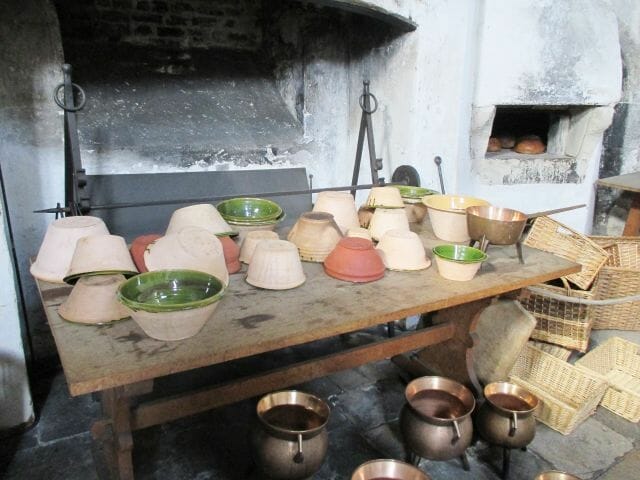
Table in the Hampton Court kitchen, filled with pudding basins! Photo: S. Ewing/ISAC
Great ceremony surrounded the making, cooking, and presenting of the Christmas pudding. Tradition indicates the plum pudding is the symbol of Christmas. The dark round or rounded pudding represents the good and abundant earth. A sprig of holly and berries is placed on top before igniting the pudding with alcohol. The holly berries stand for the blood of Christ and the flames of brandy are the flames of hell that are rapidly burned away as goodness triumphs over all. If a dessert can mean all of that then let’s raise our forks in celebration!
Christmas pudding can be made weeks or even months in advance and commonly were made even a year or years in advance. Tradition has it that the last possible day to mix together all the ingredients and give the pudding its first steaming was on “Stir-up Sunday,” the Sunday before Advent Sunday, (usually a Sunday around our American Thanksgiving holiday.) This is the Sunday when the Church of England collect begins,
“Stir up, we beseech Thee,
O Lord, the will of Thy faithful people,
that they, plenteously bringing forth
the fruit of good works.”
The prayer is a reminder to stir up real and spiritual goodies. On this day the ingredients were gathered, placed into a large mixing bowl, and stirred! For good luck, each member of the family took turns stirring the mixture from East to West (clockwise); this is the same direction of the rotation of the earth on its axis.
A true Christmas pudding of the time would have silver, never copper, coins in it. The person to receive the coin in their serving was believed to receive great fortune in the coming year. Queen Victoria began the tradition of including not only coins in her family pudding but trinkets that included a ring, charms, and a thimble. The belief is that a coin would bring a year of wealth, a ring would bring wedding, and a silver thimble foretells a happy life, but lived out as a spinster.
Charles Dickens, author of A Christmas Carol makes reference to the Christmas pudding three different times in the famous holiday story.
Ebenezer Scrooge scolds the men seeking a donation for the poor by saying, “Every idiot who goes about with Merry Christmas on his lips should be boiled with his own pudding, and a stake of holly through his heart. He should!”
More positively, “Tiny Tim was carried off to the wash-house by his brother and sister before the Christmas meal, ‘That he might hear the pudding singing in the copper!'” Traditionally, at this time in history, the pudding was steamed in the same copper wash-pot as was used for the weekly clothes washing.
But most famously, Dickens writes, “Mrs. Cratchit left the room alone-too nervous to bear witness-to take the pudding up, and bring it in. Suppose it should not be done enough! Suppose it should break in turning out! Suppose somebody should have got over the wall of the back-yard, and stolen it, while they were merry with the goose: a supposition at which the two young Cratchits became livid! All sorts of horrors were supposed.
Hallo! A great deal of steam! The pudding was out of the copper. A smell like a washing-day! That was the cloth. A smell like an eating-house and a pastry cook’s next door to each other, with a laundress’s next door to that? That was the pudding. In half a minute Mrs. Cratchit entered: flushed, but smiling proudly: with the pudding like a speckled cannon-ball, so hard and firm, blazing in half-a-quartern of ignited brandy, and bedight with Christmas holly stuck into the top. ‘Oh, a wonderful pudding!’ Bob Cratchit said, and calmly too, that he regarded it as the greatest success achieved by Mrs. Cratchit since their marriage.”
Greatest accomplishment since being married? Now that is some compliment!
During the Victorian era, once the ingredients were thoroughly mixed together, the pudding was wrapped in a cloth, reserved just for the purpose, and placed into a larger pot of boiling water, to steam for hours. Modern day has replaced the cloth with a pudding basin, making the entire process of steaming and long-term storing, much easier. A pudding basin typically has a capacity of about two-quarts, with a deep rim around the top of the bowl and indentations or notches on the bottom that make it easier to secure the strings that are tied on to hold the pudding cloth, parchment or aluminum foil securely in place during the steaming time, to prevent any water from entering.

Label from a pudding basin. Photo: S. Ewing/ISAC

Two pudding basins- 1-quart and 2-quart sizes. Photo: S. Ewing/ISAC
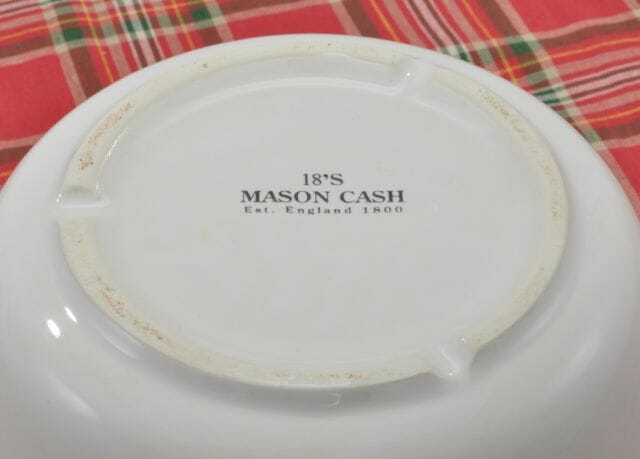
Underside of the pudding basin; you can see the three indentation for tying the string onto the basin. Photo: S. Ewing/ISAC
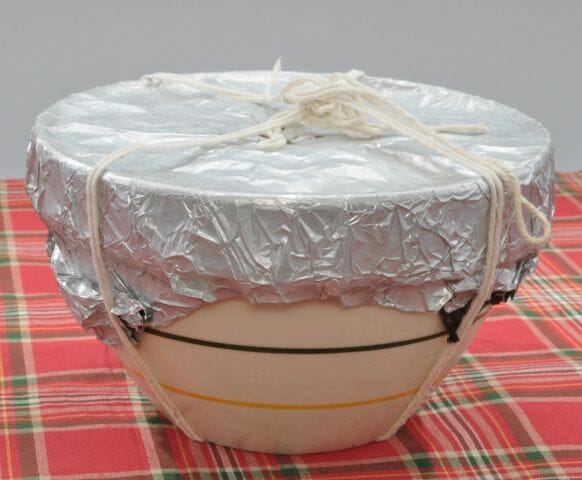
Pudding basin, covered with parchment, foil, and tied with string- ready for steaming! Photo: S. Ewing/ISAC
INGREDIENTS:
The ingredients, what actually goes into a traditional steamed Christmas pudding, are as varied as each family and each generation adapts the recipe to their own taste preferences.
Delia Smith, the Martha Stewart of Great Britain, for decades said that those who loathe Christmas pudding probably have never tasted the real thing. “The average commercial version and many of the recipes in cookery books bear little resemblance: properly made Christmas pudding is NOT heavy or cloying, but a sumptuous combination of textures and flavours that have blended together.”
A traditional Christmas pudding can include a variety of ingredients including various amounts of dried fruits (prunes, sultanas, currants, golden raisins, raisins, mixed fruit, apricots), fresh fruits (apples, lemons, oranges), carrots, nuts (almonds, walnuts, pecans), spices (cinnamon, ginger, cloves, allspice, nutmeg, mace), salt, sugar, brown sugar, bread crumbs, flour, eggs, butter, stout, wine, ale, beer, rum, brandy, black treacle, molasses, and suet.

A selection of good ciders that can be used in the pudding. Photo: S. Ewing/ISAC
Suet. This is where there can be a bit of a controversy. To use or not to use? Traditionally, suet is raw beef or mutton fat, especially the hard fat found around the loins and kidneys. Today there is the alternative vegetable suet, made from a fat such as palm oil and combined with rice flour. It resembles shredded beef suet and may be used as a vegetarian substitute in recipes, but with slightly different results from animal suet. Personally, I use the vegetable suet, because I have never found true animal suet here in the US. Of course, with the Internet I’m sure it is just a click away by mail order! Black Treacle and vegetable suet are available from British online stores such as Taste of Britain, which is located in historic downtown Norcross, Georgia.
STEAM TIME:
So, you have all of the ingredients gathered, mixed, and in your oven-proof bowl or pudding basin. Next, place a round of parchment paper on top and cover it with at least two layers of heavy duty aluminum foil and secure the foil by tying kitchen string around the bowl or basin.
Now what? The next step is the first steaming. Use a stock pot large enough to hold your pudding with additional room on the sides and top. Place a rack in the bottom of the stock pot, raised a few inches off the bottom. This can easily be achieved by using small metal portion cups or small balls of crumbled-up aluminum foil. Pour in a few inches of boiling water, place the prepared pudding on top of the rack and cover with a tight fitting lid. Bring the water to a boil and then reduce to a simmer. Keep watch on the stock pot to ensure the water does completely evaporate, and replace the water as needed. A helpful trick is to place a few glass marbles in the bottom of the pot. If the water level reaches a dangerously low level, the marbles will clatter, alerting you to add more hot water.
Puddings are cooked by hot, moist steam, not baked in a dry-heat oven. There is a large variance of steaming times. Some suggest as much as 8 hours for the first steaming, while others say as few as 3 hours is sufficient. Kitchen diva Nigella Lawson suggests a total steaming time of the first and second steaming to equal 8 hours; this seems to fall just about in the middle of suggested times. Steam your pudding for 5 hours, turn off the heat and remove the lid from the stock pot and allow to cool until bowl is cool enough to handle easily. Remove from stock pot, dry off the exterior of bowl and any water that has accumulated on top. Carefully, remove the foil and parchment paper and replace with new parchment paper and aluminum foil. Secure the new top covering with kitchen string. Store the pudding in a cool, dark place until needed. The pudding does not need to be refrigerated. In fact, according to the Dean of American cooking, James Beard, he believes the proper ageing and maturity of the pudding is not achieved if the pudding is kept too cold. If too cold, the flavors are not allowed to reach their peak.
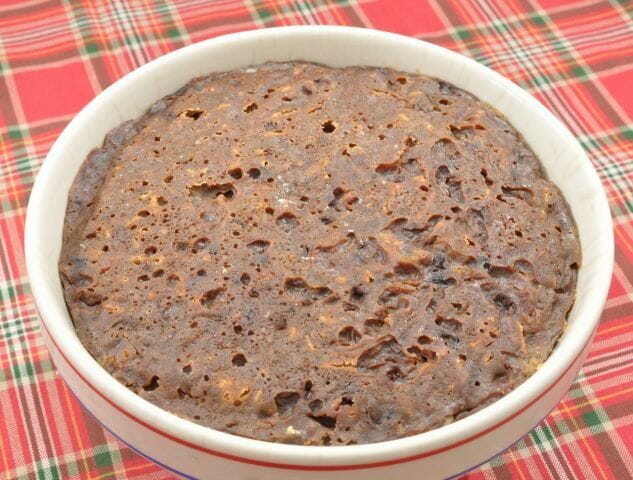
Top of the pudding, in the basin, after steaming. This pudding is ready to be turned out onto the serving platter. Photo: S. Ewing/ISAC
STORING:
Celebrated chiefs, Albert and Michelle Roux, The Roux Brothers, say Christmas pudding is at its best if left for two years before serving. However, this may not be practical for most people. Nigella Lawson believes as long as you give the pudding a proper, long, first steaming, the Christmas pudding can be made in as few as a couple of days in advance. But for truly the best flavor, try to make and steam at least a few weeks before you plan on serving.
SECOND STEAMING:
On the day the pudding is to be served, place it back into the stock pot and steam for another 3 hours. Food Network host Jamie Oliver offers a unique method for the second steaming that doesn’t fill your kitchen with hot steam, and leaves the stove cook top free for cooking, and that is to use a Crock-Pot® Slow Cooker. Simply put the bowl or basin in the slow cooker, add water about a quarter-way up the bowl, cover and turn to high. Do this at bedtime the night before and the pudding will be ready for lunch or dinner time the following day. Ingenious!
FLAMING & SERVING:
The meal has been served, the dishes cleared and everyone is waiting for dessert. Now, this is the time to turn on all of your best acting skills.
Remove the pudding from the steaming vessel; wipe the outside and top dry. Carefully remove the foil and parchment paper, taking care not to allow water to accidentally spill into the pudding. Run a thin, flexible knife around the inside of the bowl to help loosen the pudding from the bowl and invert onto a warmed oven-proof serving platter. If available, place a small sprig of holly on top.
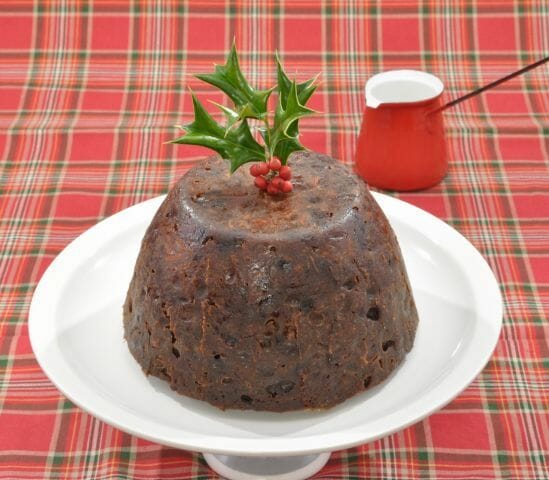
Pudding ready for flaming! Photo: S. Ewing/ISAC
Use a oven-proof measuring cup, like a 2-cup glass Pyrex® one and heat about ¼ to ⅓ cup of brandy or rum for approximately 20 seconds in the microwave oven, or in a small sauce pan on the cook top till it is just warmed.
WARNING: This is highly flammable! Use caution and best judgment. Make sure small children and stray household pets are not nipping at your ankles causing any distractions! And of course do not allow the flaming alcohol to run onto the table, table cloth, or furnishings or you will be serving holiday leftovers to your local firemen!
Carefully pour the heated alcohol of choice over the top of the pudding, dim the room lights and ignite with a long handled match or extension lighter. Using a long handle spoon, gently spoon any alcohol that may collect on the serving platter back to the top of the pudding. The holly may sizzle and burn slightly, but do not worry- this only adds to the drama and excitement. Once the alcohol has burned out, slice and serve. Garnish with whipped cream or traditional English Hard Sauce.
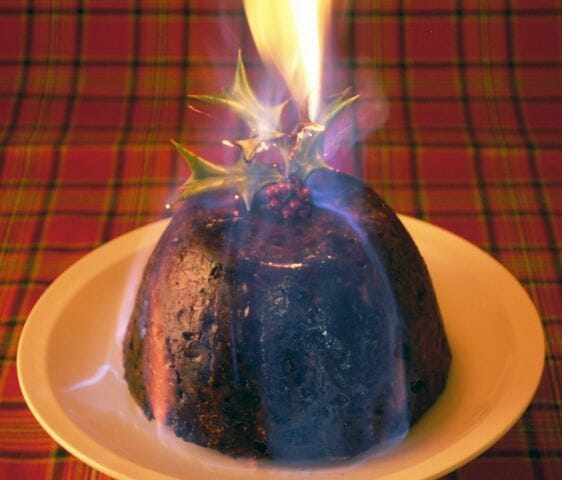
Steamed Christmas Pudding AFLAME!!! Photo: S. Ewing/ISAC (Can we all agree this photograph is amazing?! YAY SCOTT!)
Recipe for Steamed Christmas Pudding
Stephanie here again. Initally the entire recipe was going to be typed out right here. However, I decided to include it as a downloadable PDF file instead. This way it is easy for everyone to be able to click and save the recipe on your own computers or click and print the recipe out to have on hand! All you have to do is click this link: Steamed-Christmas-Pudding-2014.pdf
Hard Sauce:
¼ pound (one stick) unsalted butter, at room temperature
1½ cups powdered sugar or ½ cup brown sugar
3 Tablespoons brandy, rum or alcohol of choice
½ teaspoon vanilla extract, optional
Using an electric mixer, cream the butter and sugar until fluffy, about 3 to 4 minutes. Gradually beat in the brandy and vanilla extract, if using. Chill for at least 1 hour. Can be made several days in advance, and stored in the refrigerator.
Notes:
*It is suggested not to use rare or old, aged rum or brandy for the flaming. New or “young” spirts work best for this. A popular choice is Bacardi 151 Rum. But be careful! Remember…this stuff is highly flammable!
*It is important to have the pudding hot and the serving platter hot as well. The hotter the platter, the longer the alcohol with keep warm and the longer the flame with last.
*For truly spectacular presentation, while the pudding is flaming, sprinkle just a pinch of ground cinnamon on top. The cinnamon will burn and “sparkle” creating a dramatic effect. However, this may not be a good option for a table covered with a table cloth, as it can be a bit on the messy side.
(One last thing. American Cake Decorating Magazine has offered a truly special deal just for Chef Nicholas Lodge fans! Right now, if you buy one magazine subscription you will get one for FREE for a friend! Click here for a sweet holiday deal! Yay!)
Sweetly yours,
Stephanie and Scott
Don’t just follow our blog! Follow Chef Lodge on Facebook, Instagram, Pinterest, Twitter, Flickr, and Tumblr!






Yes, I remember the traditional Christmas Pudding at every family Christmas Dinner covered with Hard Sauce! This brings back great memories of my childhood. Thanks Stephanie and Scott. Happy Holidays!
What a great article and pictures, Scott! This might just inspire me to put one on my to-do list next year! Merry Christmas to all my ISAC friends and a very Happy New Year!
Thanks for reading Beth. Happy Holidays!
–Scott
Thank you Penny! Trust me when I say you WILL enjoy this very English dessert!
Happy New Year!
–Scott